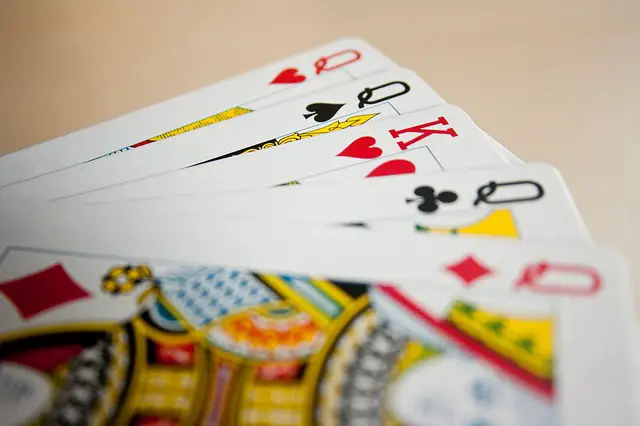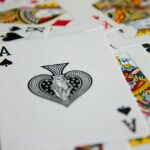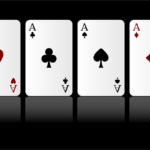
In a standard deck of 52 playing cards, there are four types of cards: diamonds, hearts, clubs, and spades. (How Many Cards in a Deck?) Each type of card has 13 cards, numbered from two to ten, and four face cards: the jack, queen, king, and ace. (See also: How Many Diamonds are in a Deck of Cards? and How Many Clubs Are in a Deck?)
These face cards have been a popular subject in literature, art, and pop culture, and have a special significance in many card games.
In this post, we will explore the history and symbolism of face cards, what the different face cards are, their significance in different games, and some interesting facts about them. (See also: What is a Face Card in a Deck of Cards?)
Table of Contents
- History and Symbolism of Face Cards
- The Face Cards in a Deck
- Red and Black Face Cards
- Face Cards in Card Games
- Face Cards in Culture
- Final Thoughts
History and Symbolism of Face Cards
The origin of face cards can be traced back to the Middle Ages when playing cards were first introduced in Europe. The original deck consisted of four suits, each with ten numbered cards and three court cards: the king, the queen, and the knave. The knave was later replaced by the jack, and the queen became a permanent fixture in the deck, possibly inspired by the Persian game of Ganjifa, which had a similar queen card.
The face cards in the deck have always had a special significance, and they have been associated with various symbolic meanings over the years. In medieval Europe, the four suits were associated with the four classes of society: diamonds with the nobility, hearts with the clergy, clubs with the peasants, and spades with the merchants.
The face cards were also assigned different allegorical meanings. The king represented power and authority, the queen represented love and beauty, and the jack represented knighthood and valor.
In some cultures, the face cards have taken on different meanings. For example, in Japan, the face cards in a deck of Hanafuda cards represent different flowers and seasons. The Chrysanthemum, Maple, and Willow cards represent autumn, while the Cherry Blossom, Iris, and Peony cards represent spring.
The Face Cards in a Deck
There are 12 total face cards in a deck of cards, the jacks, queens and kings of each of the four suits. (This means there are 40 non-face cards in a deck of 52 cards. These are also called number cards. See: How Many Number Cards are in a Deck?)
Here are the different types of face cards found in a standard deck of playing cards:
Kings
Kings are one of the three face cards in a deck of playing cards. They are typically depicted as male figures wearing crowns or other regal attire. The King card represents power, authority, and leadership.
There are usually four kings in a deck of cards, one for each suit: hearts, clubs, diamonds, and spades. (See How Many Kings are in a Deck of Cards?)
Queens
Queens are the second type of face card in a deck of playing cards. They are typically depicted as female figures wearing elegant dresses and holding a scepter or other symbols of their status. The Queen card represents beauty, grace, and femininity.
There are usually four queens in a deck of cards, one for each suit: hearts, clubs, diamonds, and spades. (See How Many Queens are in a Deck of Cards?)
Jacks
Jacks are the third type of face card in a deck of playing cards. They are typically depicted as male figures, often with a mustache, and are sometimes shown holding a weapon or tool such as a sword or a pipe. The Jack card represents cunning, wit, and resourcefulness.
There are usually four jacks in a deck of cards, one for each suit: hearts, clubs, diamonds, and spades. (See How Many Jacks are in a Deck of Cards?)
Non-Traditional Face Cards
In some decks of playing cards, there may be variations of the face cards that feature different designs or characters. For example, some decks may feature a King that is not a traditional human figure, but rather an animal or mythological creature.
Similarly, some decks may feature Queens that are not human figures, but instead represent other concepts such as nature or the elements. These variations can add to the artistic and cultural significance of playing cards.
Red and Black Face Cards
One way that face cards can be divided is by their color. The two colors in a deck of cards is red and black, with the red suits being the hearts and diamonds, and the black suits being clubs and spades.
Red Face Cards in a Deck
In most decks, the face cards are depicted with intricate designs and vivid colors, and the red face cards in particular stand out due to their bright hue. The red face cards include the jack of hearts, queen of hearts, and king of hearts, as well as the jack of diamonds and king of diamonds.
The jack of hearts is often depicted as a young man with a feathered cap, while the queen of hearts is a regal figure with a crown and flowing robes. The king of hearts is typically depicted with a full beard and a sword or scepter, giving him an air of authority and power. The jack of diamonds, meanwhile, is often portrayed as a suave and debonair figure, while the king of diamonds is shown as a wealthy and powerful ruler.
Black Face Cards in a Deck
The black face cards in a deck of playing cards typically refer to the King, Queen, and Jack cards of the spades and clubs suits. These cards are distinguished from the red face cards (King, Queen, and Jack of hearts and diamonds) by their black color.
In some parts of the world, the black face cards are associated with negative connotations, such as death or bad luck. For example, in certain parts of Europe, the King of spades is sometimes referred to as the “suicide king” due to the image of a sword through his head.
Despite these negative associations, the black face cards are an integral part of the traditional deck of playing cards and are used in countless games and gambling activities around the world. They continue to be a symbol of the rich history and cultural significance of playing cards, and their images and names have become ingrained in popular culture and media.
Face Cards in Card Games
Face cards play a crucial role in many card games and are often associated with specific values or actions. In games like Poker, Blackjack, and Bridge, the face cards hold a higher value than the number cards and can often help determine the winner of a hand.
Poker
In Poker, the Kings, Queens, and Jacks are collectively known as “court cards” and are often used to represent specific values or ranks. For example, in some variations of Poker, the King of Hearts may be considered the highest-ranking card, while the Jack of Spades may be the second-highest. In other variations, the face cards may simply be considered “wild cards,” which can take on the value of any other card in the deck.
Blackjack
In Blackjack, the face cards are all worth ten points each, regardless of their suit. This makes them valuable cards to have in your hand, as they can help you get closer to the coveted score of 21.
Bridge
In Bridge, the face cards are used to represent specific suits and values. For example, the Queen of Spades is often used to indicate a particular card or sequence of cards, while the King of Diamonds may represent a specific number of tricks that a player hopes to win.
Overall, the interpretation of face cards in card games varies widely depending on the specific rules and strategies of each game. However, they often hold significant value and can help players gain an advantage over their opponents.
Face Cards in Culture
Face cards have been a part of playing card decks for centuries, and their significance has extended beyond just the world of card games. They have appeared in artwork, literature, and other forms of popular culture, often representing powerful or important figures.
For example, the King card is often associated with royalty and power, and has been depicted in artwork throughout history as a symbol of strength and authority. The Queen card is often associated with beauty and elegance, and has been used in literature and film to represent powerful and independent women.
Jacks, on the other hand, are often seen as symbols of rebellion or trickery. They are sometimes depicted as underdogs or antiheroes, using their wit and resourcefulness to overcome powerful opponents.
In addition to their symbolism and associations with various cultural figures, face cards have also been used as a source of inspiration for artists and designers. Many decks of playing cards feature unique designs and illustrations, with each face card having its own distinct look and personality.
Overall, the cultural significance of face cards has evolved over time and varies depending on the context and cultural traditions. However, they remain an enduring symbol of power, beauty, and cunning, and continue to hold a special place in popular culture today.
Final Thoughts
Face cards are an essential part of any deck of playing cards, and their significance extends beyond just the world of card games. The Kings, Queens, and Jacks that make up the face cards are often associated with different values and traits, such as power, beauty, and cunning.
They are used in various card games, where they hold a higher value than the number cards and can help determine the winner of a hand. Additionally, face cards have appeared in art, literature, and popular culture, where they have been used to represent powerful or important figures and have inspired artists and designers to create unique and visually striking card designs.
The cultural significance of face cards continues to evolve and varies depending on the context and cultural traditions, but they remain a beloved and iconic part of playing card culture today.
The magician started magic as a kid and has learned from some of the greats. He loves to share his knowledge with others and help out with the subtleties he’s learned along the way.
Follow on YouTube at the link below to get free tricks and advice!


